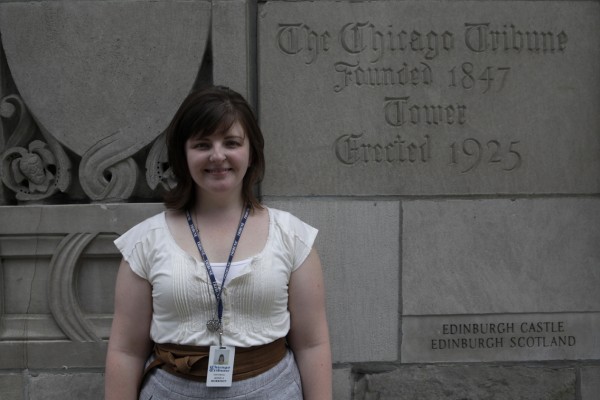30 July 2012
The journalistic method: Making the jump from science to journalism
Posted by mcadams

Jessica Morrison, AGU's 2012 AAAS Mass Media Fellow, stands in front of the Chicago Tribune tower, where she is completing her 10-week fellowship. (Photo credit: Armando L. Sanchez/Chicago Tribune)
My geology training didn’t cover the use of sedation in dentistry. In my PhD work, I never had to investigate the details of proposed guidelines for hepatitis C screenings, or the difficulties of vitamin D testing. But as the 2012 AGU-sponsored AAAS Mass Media fellow, I’ve reported on these subjects and more for the Chicago Tribune.
Working as a health reporter hasn’t been as difficult as I imagined, however. I just used the scientific method.
Pitching a story is a lot like developing a hypothesis. When I pitch a story, I tell my editor what I know about a topic and what I think I’m going to find out. Occasionally the story will write itself, but most of the time the questions lead only to more questions!
For a reporter, asking questions and listening to the answers is very much the same as conducting an experiment. I’ve spoken with health regulators, medical doctors, nurses, patients, caretakers, pathologists, clinical chemists, anesthesiologists, and biologists. Sometimes their answers don’t make sense. Sometimes a question must be rephrased. There are times when you’ll have to scrap an interview and start over in a different way. Some answers will take you by surprise. But sometimes, when you’ve set up the questions in just the right way, you’ll find exactly the results you hoped for.
Keep in mind, though, objectivity is an important tenet of journalism. A journalist must take care to stay out of the story in the same way that a scientist must avoid misrepresenting results. The hypothesis must not sway the results.
Ah, the results. For journalists and scientists alike, reporting observations is the highest aim. The best of both disciplines report clearly, concisely and without bias.
In two short weeks, I will return to the University of Notre Dame to finish up my doctorate in actinide geochemistry. I’ll take back with me what I’ve learned from the newsroom—how to research a completely foreign topic on a deadline, how to ask stupid questions without fear, and how to write concise, clear stories free of jargon. After that, I hope to take my science experience into a newsroom permanently.
In the meantime, I would love to hear your story ideas. Drop me a line at jmorrison (at) tribune (dot) com.
The AAAS Science and Engineering Mass Media Fellowship, nearly 40 years old, places advanced science students in newsrooms across the country for 10 weeks during the summer. Fellows report alongside seasoned journalists, learning to work on tight deadlines, translate scientific jargon and get quickly to the point. My fellowship is sponsored by AGU.
— Jessica Morrison, AGU’s 2012 AAAS Mass Media Fellow










 The Plainspoken Scientist is the science communication blog of AGU’s Sharing Science program. With this blog, we wish to showcase creative and effective science communication via multiple mediums and modes.
The Plainspoken Scientist is the science communication blog of AGU’s Sharing Science program. With this blog, we wish to showcase creative and effective science communication via multiple mediums and modes.